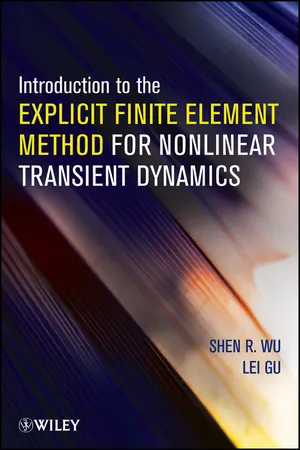
Introduction to the Explicit Finite Element Method for Nonlinear Transient Dynamics
- English
- ePUB (mobile friendly)
- Available on iOS & Android
Introduction to the Explicit Finite Element Method for Nonlinear Transient Dynamics
About this book
A systematic introduction to the theories and formulations of the explicit finite element method
As numerical technology continues to grow and evolve with industrial applications, understanding the explicit finite element method has become increasingly important, particularly in the areas of crashworthiness, metal forming, and impact engineering. Introduction to the Explicit Finite Element Method for Nonlinear Transient Dynamics is the first book to address specifically what is now accepted as the most successful numerical tool for nonlinear transient dynamics. The book aids readers in mastering the explicit finite element method and programming code without requiring extensive background knowledge of the general finite element.
The authors present topics relating to the variational principle, numerical procedure, mechanical formulation, and fundamental achievements of the convergence theory. In addition, key topics and techniques are provided in four clearly organized sections:
• Fundamentals explores a framework of the explicit finite element method for nonlinear transient dynamics and highlights achievements related to the convergence theory
• Element Technology discusses four-node, three-node, eight-node, and two-node element theories
• Material Models outlines models of plasticity and other nonlinear materials as well as the mechanics model of ductile damage
• Contact and Constraint Conditions covers subjects related to three-dimensional surface contact, with examples solved analytically, as well as discussions on kinematic constraint conditions
Throughout the book, vivid figures illustrate the ideas and key features of the explicit finite element method. Examples clearly present results, featuring both theoretical assessments and industrial applications.
Introduction to the Explicit Finite Element Method for Nonlinear Transient Dynamics is an ideal book for both engineers who require more theoretical discussions and for theoreticians searching for interesting and challenging research topics. The book also serves as an excellent resource for courses on applied mathematics, applied mechanics, and numerical methods at the graduate level.
Frequently asked questions
- Essential is ideal for learners and professionals who enjoy exploring a wide range of subjects. Access the Essential Library with 800,000+ trusted titles and best-sellers across business, personal growth, and the humanities. Includes unlimited reading time and Standard Read Aloud voice.
- Complete: Perfect for advanced learners and researchers needing full, unrestricted access. Unlock 1.4M+ books across hundreds of subjects, including academic and specialized titles. The Complete Plan also includes advanced features like Premium Read Aloud and Research Assistant.
Please note we cannot support devices running on iOS 13 and Android 7 or earlier. Learn more about using the app.
Information
Table of contents
- Cover
- Title Page
- Copyright
- Dedication
- Preface
- Part I: Fundamentals
- Part II: Element Technology
- Part III: Material Models
- Part IV: Contact And Constraint Conditions
- References
- Index